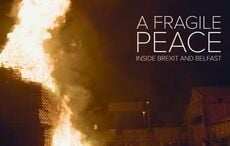Two years ago a hard-hitting poster campaign by the Australian government sought to scare away asylum seekers and undocumented immigrants.
The controversial poster – which was printed in 17 languages – read: "No way. You will not make Australia home.”
The poster, which quickly went viral worldwide, depicted a small ship tossed on a threatening sea to make the Australian government’s point that the danger to life and limb wasn’t worth it.
At the time, critics called it the anti-refugee campaign of the century, but it appears that its hard-hitting message has been surpassed in 2016.
It’s estimated that there are 65 million refugees on the move globally, the highest number since 1945, but critics say no national response has been crueler to their plight than the quasi-prisons built by Australia for its comparatively modest migrant influx (an estimated 1,852 in total are being detained).
For years the United Nations’ refugee agency has assured Australia that its policy of banishing refugees and asylum seekers to two remote offshore prisons on Pacific islands is illegal.
But in an attempt to resolve the long-festering dispute the agency is now working with the Australian government to send some of the longtime refugees to the United States, where it plans to resettle them.
The plan was announced last month by Australia with the aim of shutting down two facilities - one located on the island of Nauru and the other on Manus Island in Papua New Guinea - where hundreds of intending immigrants have been detained for years in what rights groups describe as appalling conditions.
But although the United States has agreed to harbor some of them, the question of how many, where, and how soon is still unresolved.
As the plight of the refugees continues to make international headlines, Volker Turk, assistant high commissioner with the United Nations’ refugee agency, told The New York Times that his staff would help with the screening and resettlement but only as a “one-off” to allay their suffering, which is increasingly being documented by the world’s press.
“We think there is an urgent imperative to find a humanitarian way out of this otherwise very, very, complex conundrum,” he told the press.
Meanwhile, a report last month by Amnesty International claimed that Australia’s offshore detention plan “essentially amounts to torture.”
But the head of Australia’s immigration department Michael Pezzullo said he found the idea “offensive” and immediately rejected the claim. Australian Prime Minister Malcolm Turnbull also rejected the report adding, “It is absolutely false.”
UN reports of refugee children attempting suicide or of detainees setting themselves on fire are tempered by the Australian public’s approval for the measures keeping immigrant boats from reaching their shores.
On the two islands, multiple reports tell of overdoses and self-immolation, death from medical negligence, sexual abuse and rampant depression and despair. A recent UN report found that 88 percent of the 181 asylum seekers and refugees on Manus island were suffering from depressive disorders including, in some cases, psychosis.
America has given a commitment to take in an unspecified number of the refugees over an unspecified period, with priority reportedly going to the women, children and families currently on Nauru.
The single men on Manus island will be among the second tier of asylum grantees if they accepted at all with Donald Trump as president.
The hard-line stance of the Australian government offers a marked contrast to the old days. Back in 1928, Australia advertised itself as a land of opportunity – but the people it was advertising to lived in the UK and northern Europe.
After the Second World War, the country even offered British immigrants a subsidized boat trip for just ten pounds to their new land of opportunity.
Now critics say it’s ironic a country founded by Europeans (at the well-documented expense of the indigenous peoples who lived there) has the gall to declare itself off limits to foreigners.




Comments